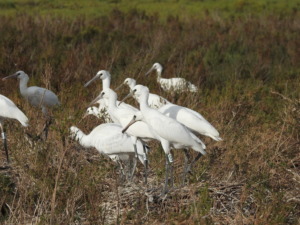Context

Scientists can often identify most bird species by sight, but are generally unable to identify individuals. However, individual identification is essential for a better understanding of how populations function, as individual behaviour can vary. The systematic ringing of birds with an individual code is a technique that began in Europe in 1899. Bird ringing has provided invaluable information on the biology and ecology of birds, allowing researchers to gather important data on their behaviour, migration routes, survival rates and population dynamics (Baillie 1995; Anderson & Green 2009).
Eurasian Spoonbill is a large waterfowl emblematic of wetlands. In several colonies in Europe, individually are marked as chicks with an engraved coloured PVC ring that allows individual visual identification at a distance (resightings). Resightings of the codes on these PVC rings are usually carried out by experienced observers using telescopes, often from a hiding place. Since 2016, we have been progressively using automated camera traps in the Camargue, southern France, to complement or replace direct observation methods (Figure 1). Our intention was to increase the total number of individual adult breeders identified and to minimise disturbance to the colony. However, this has resulted in the collection of approximately 30,000 to 50,000 photographs per year, which have to be manually processed in the office. In addition, detecting and reading these marks is a tedious and time-consuming task. To address this new challenge, we have developed and tested machine learning techniques and autonomous processing using trained classifiers such as deep convolutional neural networks. Dedicated students and another study (Santangeli et al. 2020) have made significant progress over the last two years (Figure 2), particularly in identifying the rings visible in the images, but further studies are needed to automate the extraction of the codes.
Objective
The objective of this internship is to develop a reliable method in order to detect the rings on pictures and read the rings located. Specifically, the internship will consider three steps in sequence:
1) Optimization of the current object detector, trained on a mix of synthetic data and real data, to include the latest version of standard object detectors, and specifically YoLo (v8 or later). Considering object-aligned bounding box would definitely help the detection. On another direction, the current detector was trained on either full tags or individual letters. The internship should include a finalization of the choice between one approach and the next.
2) Tag reading: once the tags or the letters will have been detected, the next stage will be to identify the letters. First experiments on this topic with the letter detector indicated that some letters were often misdetected, leading to incomplete tag detection. A full tag detector may require different approach for reading the complete text and handle occlusion.
3) Quantitative evaluation: given the complexity of the hand-labeled data and the sparsity of the labels, a specific study will be required to develop a protocol for quantitative evaluation of the performance in terms of standard machine learning, image processing methods, but also in terms of ecological evaluation.
Skills
Good knowledge of Python programming and image processing
Ability to write and summarise
Autonomy in conducting a research project
Driving licence and private car recommended
Ability to speak and understand French is appreciated
Interest in wildlife and conservation is preferable
Supervision
Prof. Cédric Pradalier, GeorgiaTech Lorraine Europe, Metz, France.
Dr. Jocelyn Champagnon, Tour du Valat, Arles, France.
Support
Christophe Germain, Database & Web Developer, Tour du Valat, France.
Dr. Arnaud Béchet, Researcher, Tour du Valat, France.
Hugo Ferreira, PhD student, University of Aveiro, Portugal and Tour du Valat, France.
Host structure
The internship is hosted by the Tour du Valat, near Le Sambuc, 13200 Arles. The Tour du Valat is a private foundation dedicated to the study and conservation of Mediterranean wetlands. Founded in 1954, it works in the field of multidisciplinary ecological research. The Tour du Valat employs around 80 people, including around twenty research and project managers and around twenty doctoral students and volunteers. With an estate of 2,600 ha, the Tour du Valat has laboratory facilities, experimental sites and offices in the heart of wetlands and other diverse Mediterranean habitats.
- Length of the traineeship: 6 months
- Period: from February 2024
- Accommodation on site in a shared room at a cost of around €70 per month
- Preferential meal rate at the Tour du Valat (€3 per meal)
- Shared office at the Tour du Valat
- Statutory internship allowance: €659/month
- A 2-week stay in Metz is planned along the 6 months internship
How to apply
Applications should be sent to Jocelyn Champagnon and Cédric Pradalier by 5 November 2023, including a covering letter and a CV.